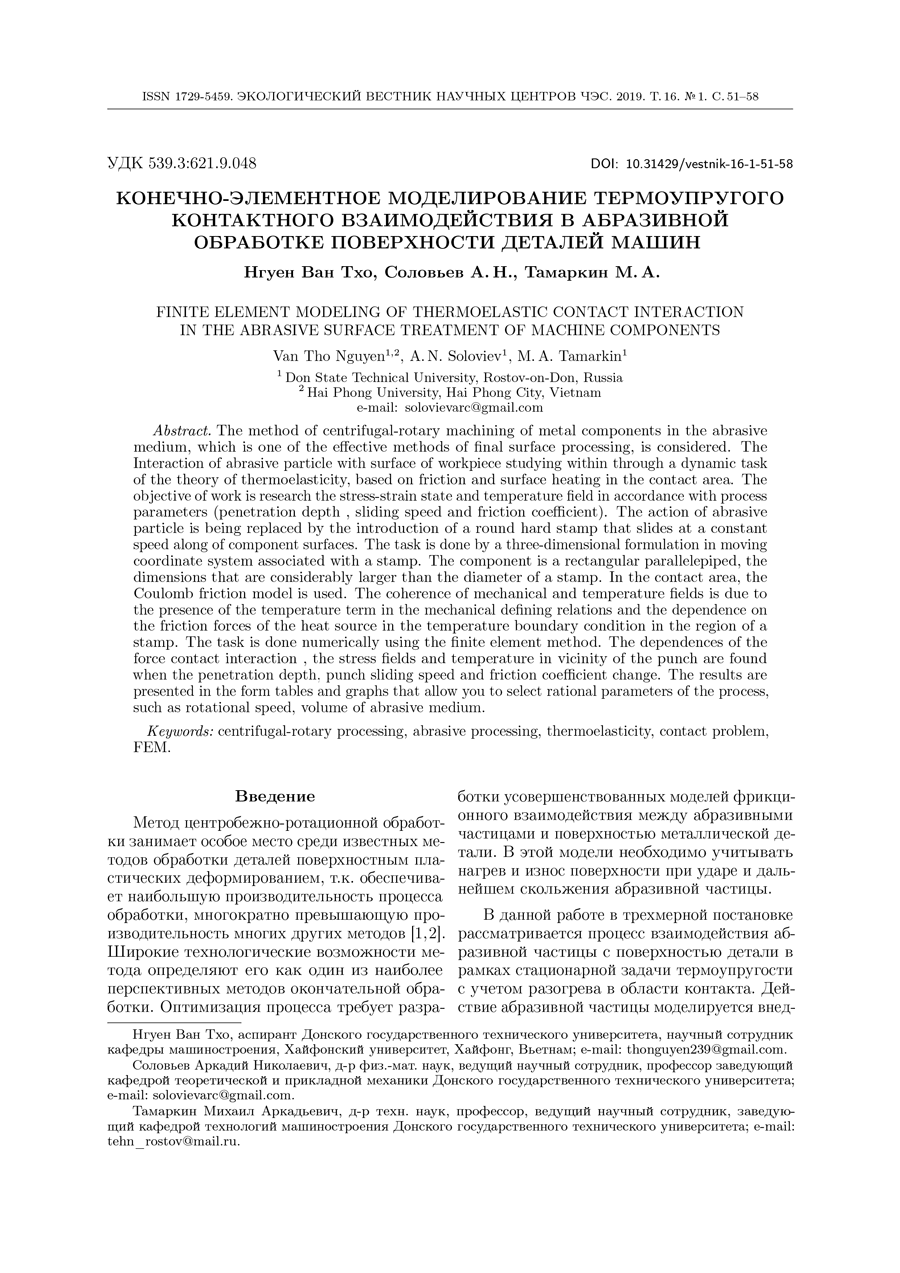Finite element modeling of thermoelastic contact interaction in the abrasive surface treatment of machine components
UDC
539.3:621.9.048DOI:
https://doi.org/10.31429/vestnik-16-1-51-58Abstract
The method of centrifugal-rotary machining of metal components in the abrasive medium, which is one of the effective methods of final surface processing, is considered. The Interaction of abrasive particle with surface of workpiece studying within through a dynamic task of the theory of thermoelasticity, based on friction and surface heating in the contact area. The objective of work is research the stress-strain state and temperature field in accordance with process parameters (penetration depth , sliding speed and friction coefficient). The action of abrasive particle is being replaced by the introduction of a round hard stamp that slides at a constant speed along of component surfaces. The task is done by a three-dimensional formulation in moving coordinate system associated with a stamp. The component is a rectangular parallelepiped, the dimensions that are considerably larger than the diameter of a stamp. In the contact area, the Coulomb friction model is used. The coherence of mechanical and temperature fields is due to the presence of the temperature term in the mechanical defining relations and the dependence on the friction forces of the heat source in the temperature boundary condition in the region of a stamp. The task is done numerically using the finite element method. The dependences of the force contact interaction , the stress fields and temperature in vicinity of the punch are found when the penetration depth, punch sliding speed and friction coefficient change. The results are presented in the form tables and graphs that allow you to select rational parameters of the process, such as rotational speed, volume of abrasive medium.
Keywords:
centrifugal-rotary processing, abrasive processing, thermoelasticity, contact problem, FEMReferences
- Gillespie Laroux. Deburring and Edge Finishing. Handbook. SME. ASMEPRESS. New York, Michigan, 1999.
- Tamarkin, M.A., Tishchenko, E.E., Korol'kov, Yu.V., Rozhnenko, O.A. Povysheniye effektivnosti tsentrobezhno-rotatsionnoy obrabotki v srede abraziva [Improving the efficiency of centrifugal-rotary treatment in an abrasive medium]. STIN, 2009, no. 2, pp. 26–30. (In Russian)
- Tamarkin, M.A., Tishenko, E.E., Druppov, V.V. Issledovaniye udaleniya metalla pri tsentrobezhno-rotornoy obrabotke v abrazivnoy srede. [The study of metal removal during centrifugal-rotary processing in an abrasive medium.]. Vestnik Rybinskoy gosudarstvennoy aviacionnoy tehnologicheskoy akademii im P.A. Solov'ev. [Bulletin of the Rybinsk State Aviation Technological Academy], 2007, no. 1 (11), pp. 169–186. (In Russian)
- Tamarkin, M.A., Rozhnenko, O.A., Tishchenko, E.E., Korolkov, Yu.V. Teoreticheskiye i eksperimental'nyye issledovaniya protsessov obrabotki fasonnykh poverkhnostey detaley svobodnym abrazivom. [Theoretical and experimental studies of the processing of shaped parts surfaces with free abrasive]. Uprochnyayushchiye tekhnologii i pokrytiya [Strengthening technologies and coatings], 2011, no. 11, pp. 27–31. (In Russian)
- Kragel'skiy, I.V. Treniye i iznos [Friction and wear]. Mashinostroyeniye [Mechanical engineering], 1968. (In Russian)
- Shvedova, A.S. Obespecheniye nadezhnosti tekhnologicheskogo protsessa tsentrobezhno-rotatsionnoy otdelochno-uprochnyayushchey obrabotki [Maintenance of reliability of technological process of centrifugal-rotational finishing-hardening processing]. Vestnik DGTU [Bulletin of the DSTU], 2014, no. 4, pp. 69–83. (In Russian)
- Grützmacher, Ph.G. The influence of centrifugal forces on friction and wear in rotational sliding. Tribology International, 2017, no. 116, pp. 256–263. DOI: 10.1016/j.triboint.2017.07.021
- Wenhui, Li, Zhang, Li, Xiuhong, Li, Shengqiang, Yang, Fengfeng, Wu. Theoretical and simulation analysis of abrasive particles in centrifugal barrel finishing: kinematics mechanism and distribution characteristics. Powder Technology, 2017, no. 318, pp. 518–527. DOI: 10.1016/j.powtec.2017.06.033
- Morton K.W., Mayers D.F. Numerical solution of partial differential equations. Cambridge University Press, New York, 2005.
- PDE Solution Inc. Available at: https://www.pdesolutions.com
Downloads
Submitted
Published
How to Cite
Copyright (c) 2019 Nguyen T.V., Soloviev A.N., Tamarkin M.A.

This work is licensed under a Creative Commons Attribution 4.0 International License.




